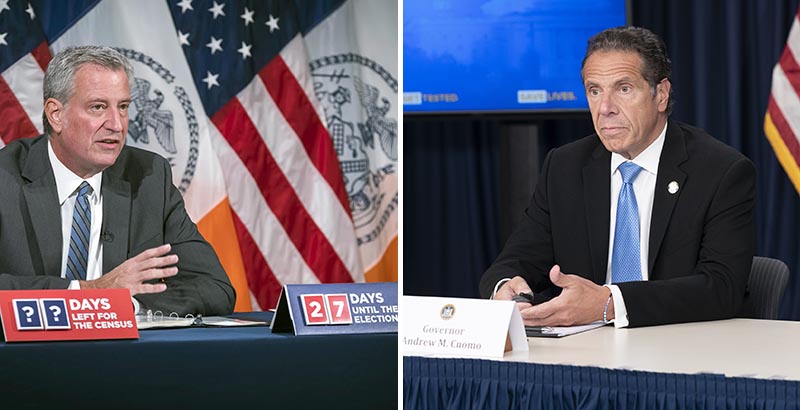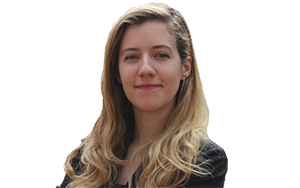As the Governor and the Mayor Disagree, NYC Parents and Educators Search for Clear Guidance on In-Person Schooling

Updated, Oct. 11
For Brooklyn parent Priscilla Santos, New York Gov. Andrew Cuomo’s Tuesday announcement that he was releasing his own plan for temporary New York City COVID-related school closures dispelled any lingering remnants of faith she had in political leadership after a bleak, confusing summer.
Santos is the special education representative for her district’s Community Education Council in Coney Island. Her children, ages 12 and 14, attend Mark Twain I.S. 239 for the Gifted and Talented, where they study media and art. The area where her family resides is currently marked yellow on the governor’s map, signaling that school closures could happen there, if neighborhood positivity rates worsen.
Meanwhile, the blocks around nearby Brighton Beach Avenue and the famed amusement park are marked orange. The confounding boundary between Santos’s zip code and the “hotter” neighboring ones cut right through some streets and buildings, she noticed.
The advocate and mother knows the value of virus containment measures firsthand: her community was among those hit hardest when the pandemic overtook the city this spring. Still, she’s troubled by the way officials have laid everything out.
“I understand they need to stop the spread,” she said during a recent phone call, interrupted occasionally by the sound of her dog barking and a timer going off, a reminder to check in with her kids to make sure their schoolwork was still on track. “The lack of communication and proper decisiveness from those who are supposed to be in charge has made parents more anxious, and creates more anxiety for the kids.” Santos had a message for Cuomo and Mayor Bill de Blasio: “Stop kicking the can down the road.”
It’s been a tumultuous last few months for de Blasio and schools Chancellor Richard Carranza — and by extension, for the families, administrators and staff in the country’s largest school district. On Monday, the mayor said he was going to shutter all schools in nine zip codes with a 3 percent seven-day positivity rate, adding that they would have to close temporarily for two to four weeks, until the numbers fell again. . All told, the mayor ended up closing 124 schools in nine zip codes.
On Tuesday, the governor presented his own version of the plan, along with the map demarcating yellow, orange and red zones, sparking confusion and whipping administrators, educators and families into a frenzy. Sixteen of the schools that were given permission to reopen by the state were told by the city that they need to stay shut, sparking parent protests on Thursday.
Already, the mayor had twice bumped back the start of school at the last minute: first from Sept. 10 to Sept. 21, and then again on Sept. 17 to a Sept. 29 start date for elementary schools, and a Oct. 1 start date for middle and high schools. Now that certain communities are seeing an uptick in positivity rates — a potential problem that public health experts have been forecasting for months — Santos said she worries that the same disorganization that has plagued leadership is coming to pass again.
On Thursday, the mayor announced that teachers wouldn’t be receiving the $900 million in back pay that they’re due for several years. He attributed it to three factors: the city’s $9 billion pandemic-driven shortfall, the federal stimulus that never came, and his inability to win borrowing authority from the state. “We can’t afford it right now, given that nothing else has come to support us,” de Blasio told Brian Lehrer on his radio show Friday.
The United Federation of Teachers immediately invoked its right to proceed to arbitration and by Friday evening, an arbitrator had overturned the city’s decision, ordering officials to pay half of the amount owed this month and the other half next fiscal year. The decision also requires the city to pledge that no UFT members will be laid off for the rest of the school year and safeguards their May 2021 3 percent raise.
As of last Monday, families of half of the district’s 1.1 million students had opted for all-remote instruction, reflecting the ongoing upheaval and a growing lack of confidence in the district’s organization around in-person learning this fall where students spend one to three days a week in school and the rest of the time doing virtual learning from home.
Proactive containment measures are an important way to curb the virus’s spread, according to medical experts. New York City’s seven-day positivity rate hit 1.75 this week, an increase from a .9 percent low on Sept. 4. In some zip codes, including those adjacent to Santos’s, those numbers have been higher for days now: parts of Brooklyn’s Borough Park, for instance, have had daily positivity rates above 8 percent.
Under the latest plan, schools in the so-called “hotspot” zones will be closed for two to four weeks, either until those neighborhoods stay below a 3 percent positivity rate for seven consecutive days, or until four weeks have passed, with a positivity rate under 3 percent on the last day.
Teachers and caretakers interviewed by The 74 expressed anxieties about the families who inevitably travel between zip codes, echoing a point made in a recent press conference by the mayor’s senior public health advisor, Dr. Jay Varma.
“We are quite concerned that even if the problem is primarily occurring in selected areas of the city, we’re all connected,” he said. “We all breathe the same air. We do business with each other. We see each other in other places. So we have to maintain vigilance everywhere we are.”
Kaitie Maguire teaches kindergarten and first grade students with special needs whose parents have opted them into full-time remote learning. While her school, Queens Explorers Elementary School in Ozone Park, isn’t in a hotspot, she lives in one — Brooklyn’s Marine Park — and in recent days she’s worried about potentially rising cases at her school.
“You don’t want to wait until the cases start popping up in schools,” she said, adding of the temporary shutdowns, “It’s a good safety precaution. I’d rather be safe than sorry.”
Critics of politicians at both the state and city level say that months of poor communication between government officials and the public — and political tussles between Cuomo and de Blasio, familiar adversaries before COVID — have left administrators, teachers and families exhausted, and many jaded about the ability to leverage the district’s paltry funds to great effect.
“After all the progress we’ve made, it’s tough to think of any rewind, of any pause … but we have to do this now,” the mayor said at a press conference Monday. “We’re proposing a very tough plan of action to address this situation, and to ensure that it does not turn into a second wave all across New York City.”
One of Maguire’s friends, also a special needs teacher, volunteered herself for testing on Tuesday, when health professionals visited her school in Marine Park.
That teacher, who asked not to be named out of concern over attracting attention from the Department of Education in uncertain times, said that, among the group of about 30 being tested, only one or two were students.
“Kids were only tested if parents gave consent,” she said. “I’d imagine some parents aren’t comfortable with it yet.”
While medical experts have repeatedly said that thorough testing and contact tracing are critical for getting schools up and running safely, Santos said that some parents in her community, including herself, are afraid of their kids being tested in schools.
The 10 to 20 percent random monthly testing of staff and students was part of the deal the city and UFT struck in order to get the teachers union to agree on the schools reopening plan. It started Friday, with families having been told that if students don’t consent to testing, they’ll be placed in all-remote learning.
Santos said she brought her children to their local pediatrician in September, prior to the initial schools start date. Even with the doctor’s coaxing, the kids found the nasal swab jarring, she said. Lately, she’s been spending a lot of time scanning local parent Facebook groups, searching for answers and finding a lot of fear around in-school testing that mirrors her own.
Due to that anxiety, and the uneasiness stemming from the back-and-forth messaging from city leadership, Santos eventually decided to pull her kids from the blended learning option.
“To have this shutdown when families were adjusting to the schedule that was created, shutting it down once they’re in the routine of things — they’re leaving working parents and their kids stranded,” she said. “Leaders need to take parents’ perspectives into the decision-making process.”
Cuomo’s order also shut down all private and religious schools in the hotspot zones, including many yeshivas in communities where officials suspect the virus might be spreading more than others, and also any charter schools. James Merriman, the chief executive officer of the New York City Charter School Center, said many of these schools already decided months ago not to return to in-person learning in buildings they share with New York City public schools because they were worried about potential back-and-forth closures.
“Instead of trying to force a square peg into a round hole, a lot of them — as much as they wanted to do hybrid learning — from the get-go made the decision that they would start remote and then reexamine how things were going, say someday in November or December,” he said. “Everyone can understand there are difficult decisions to make. It’s the whipsawing, I think, that has frustrated parents the most.”
On Wednesday evening, much to the chagrin of the staff at the Marine Park teacher’s school, the mayor announced they would be going fully remote, based upon their zip code. Around Thursday night, she said she and her colleagues got their test results. They were negative.
Get stories like these delivered straight to your inbox. Sign up for The 74 Newsletter

;)
